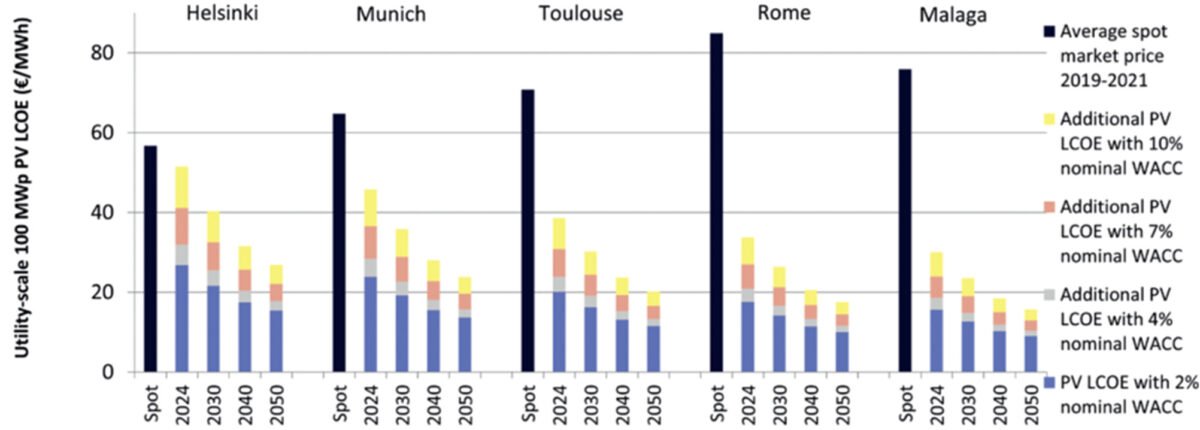In its latest monthly column for pv magazine, the European Technology and Innovation Platform for Photovoltaics (ETIP PV) presents its levelized cost of electricity (LCOE) calculations for several European locations from 2023 to 2050. The organization predicts that solar LCOEs in Europe could decline up to 50% by 2050.
According to the international magazine pv.
The cost of solar photovoltaic systems has fallen significantly over the last ten years. The actual market prices of PV modules have decreased by approximately 95% since 2011. In most countries, photovoltaics have even caught up with retail and wholesale electricity costs.
For further analysis of the photovoltaic market and prices, the European Technology and Innovation Platform for Photovoltaics (ETIP-PV) recently published its Levelized Cost of Electricity (LCOE) calculations for the period from 2023 to 2050. The LCOE of electricity produced by photovoltaics was analyzed. for five locations in Europe (Helsinki, Munich, Toulouse, Rome and Malaga) and four types of photovoltaic systems (residential 5 kW, commercial 50 kW, industrial 1 MW and utility 100 MW).
Photovoltaic LCOE depends on production costs and includes all costs related to the delivery of photovoltaic energy to the grid connection point. It also depends on the investment (CAPEX) and operating (OPEX) costs of the photovoltaic system. OPEX includes costs and profit margins throughout the value chain, including financing, project development, manufacturing, installation, operation and maintenance.
For decades, module prices have closely followed a so-called learning curve, meaning that every time the world’s cumulative PV production capacity doubles, module prices fall by about 25%. Based on this historical learning rate, module prices are expected to decline over the coming decades, primarily due to improved manufacturing processes, more efficient use of materials, and continued improvements in module efficiency. In addition to the historical learning rate of 25%, the calculations also take into account annual inflation of 2%, a lifetime of 30 years for rooftop systems or 35 years for ground installations, and an annual degradation of 0.5% in all cases.
Main findings
Under the ETIP PV base case, cumulative global PV capacity would increase from 1.5 TW at the end of 2032 to around 5.5 TW by 2030 and 30 TW by 2050.
The OPEX of large solar power plants is expected to increase from 12.5 EUR/kW/year at the end of 2023 to 9 EUR/kW/year in 2050. For rooftop solar power plants, this figure could reach 10 EUR/kW/year.
On the CAPEX side, costs for large solar plants are expected to increase from €0.46/W at the end of this year to €0.23/W in 2050, while residential (5 kW) and commercial solar (50 kW) and industrial (1 MW), could reach EUR 0.81, EUR 0.48 and EUR 0.33. Across all sectors, investment spending has almost halved between January 2024 and 2050.
Overall, PV LCOEs are expected to decrease by around 20% by 2030 and by 50% by 2050 compared to current values. If we refer to average wholesale electricity prices in 2019-2021, large-scale PV would already be competitive with a nominal weighted average cost of capital (WACC) rate well above 10% in all countries. Note that during the energy crisis in Europe in 2022, spot market prices were much higher, making PV even more competitive.
Image: European Technology and Innovation Platform for Photovoltaics (ETIP PV)
ETIP PV predicts a decrease in LCOE for all locations, with the decrease being particularly pronounced in Rome and Malaga. For example, in Malaga, the LCOE of large PV with a nominal WACC of 7% is €24/MWh in 2024, but is expected to drop to €19/MWh and €13/MWh in 2030. 2050. However, the LCOE predictions for all locations are very positive, indicating that PV electricity is already cheaper in all five locations with all real WACC rates and all consumer segments.
The full information document, which includes all information related to residential, commercial and industrial LCOEs, is available in the ETIP PV publications list. If you would like more information about ETIP PV events and activities, follow us through our monthly newsletter, our monthly articles in magazine pv or our LinkedIn channel. Additionally, if you’d like to work with us, consider joining one of our working groups – we’re always looking for PV experts and enthusiasts.
Translated by Marie Beyer.
The views and opinions expressed in this article are the author’s own and do not necessarily reflect those held by him magazine pv.
This content is copyrighted and you may not reuse it without permission. If you would like to collaborate with us and reuse our content, please contact our editorial team at the following address: editors@pv-magazine.com.

